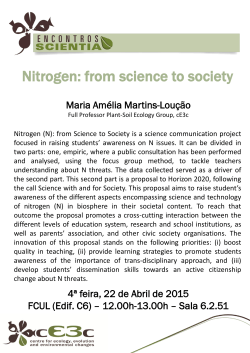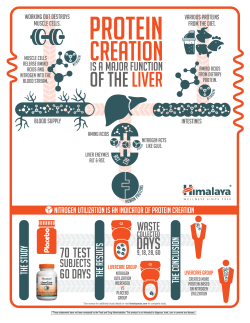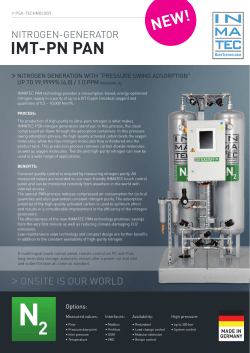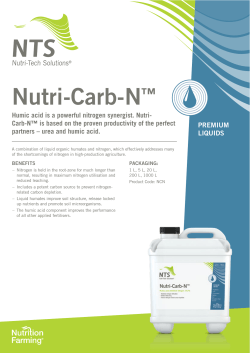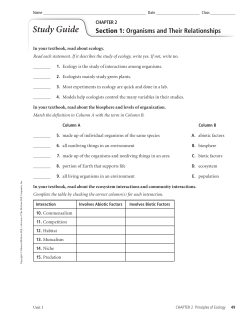
CARBON & NITROGEN CYCLES
carbon & nitrogen cycles reflect The story of Goldilocks and the Three Bears describes how the little girl, Goldilocks, preferred the porridge that was neither too cold nor too hot, but “just right.” Much like Goldilocks, certain conditions within an ecosystem cannot tilt too far to one or another extreme. Ecosystems thrive when conditions are balanced, or “just right.” Take a look at the photograph on the right. What are some of the components—living and nonliving—of this ecosystem? How might conditions in the ecosystem—the amount of rainfall, the nutrients in the soil, the number of organisms within each population—fall out of balance? How might such changes affect the ecosystem? Elements such as carbon cycle through the atmosphere and biosphere. Systems on Earth are healthiest when their various components are balanced. One important element that contributes to this balance is carbon. Carbon moves between living and nonliving things on Earth. These movements make up the carbon cycle. Like all cycles, the carbon cycle has neither beginning nor end. Instead, it consists of a number of related processes. One part of the carbon cycle centers on photosynthesis. Carbon exists in Earth’s atmosphere primarily within molecules of carbon Carbohydrates such as this molecule of glucose dioxide (CO2). During the Calvin (left) have a carbon backbone. Foods made cycle of photosynthesis, plants from grains, such as bread and pasta (right), are use the carbon (C) from CO2 to complex forms of carbohydrates. make organic compounds called carbohydrates. One of the most important of these carbohydrates is glucose (C6H12O6), a sugar that plants use for food. Plants can store glucose for later consumption in the form of starch, another type of carbohydrate. Another important part of the carbon cycle occurs when organisms consume carbohydrates produced by plants. These consumers use the energy held within the chemical bonds of the molecules to fuel their cellular activities. For example, in an animal’s cells, carbohydrates undergo a series of chemical reactions that break down the molecule to release energy. This process is called cellular respiration. One of the waste products of cellular respiration is carbon dioxide. Because animals cannot use carbon dioxide, they exhale it into the atmosphere where plants can once again use it to make carbohydrates. In this way, carbon cycles continually between the atmosphere (as carbon dioxide) and the biosphere (as carbohydrates). © 2013-2014 Accelerate Learning - All Rights Reserved 183 carbon & nitrogen cycles Carbon in biomass—the living (or recently living) matter in atmosphere: the an ecosystem—is also returned to the environment through layer of gases that decomposition. The bodies of organisms are primarily made surrounds Earth up of carbon. When an organism dies, worms, bacteria, and other decomposers break down the body into its component elements. In this way, carbon moves from biomass into the biosphere: the ground, where it can remain buried for thousands of years. living things on Over millions of years, extreme heat and pressure from Earth and their Earth’s interior transformed buried plants and animals from the environments Carboniferous period (approximately 300–350 million years ago) into fossil fuels such as coal, petroleum, and natural gas. When humans burn fossil fuels—to power machines, generate electricity, and heat buildings— the carbon cycles back to the atmosphere, where it can be used again by plants during photosynthesis. Photosynthesis, respiration, and decomposition happen in the oceans as well as on land. In the oceans, carbon cycles between the surface ocean, the deep ocean, and the seafloor. These movements are part of the carbon cycle. 184 © 2013-2014 Accelerate Learning - All Rights Reserved carbon & nitrogen cycles look out! Humans contribute to the carbon cycle by burning fossil fuels and other forms of biomass, such as wood. (Biomass also burns through natural processes. For example, a bolt of lightning can spark a forest fire.) However, over the past few centuries, humans have released huge quantities of carbon into the atmosphere—more than can be absorbed through photosynthesis and other natural processes. Scientists have evidence this excess carbon dioxide is trapping heat at Earth’s surface, leading to global climate change. Nitrogen also cycles between Earth’s atmosphere and biosphere. Both plants and animals require nitrogen to survive. It is a key component of DNA, RNA, and amino acids, which are used to form proteins in living organisms. Approximately 78% of Earth’s atmosphere is nitrogen gas (N2), but most living things cannot use nitrogen in this form. Only certain types of bacteria can take nitrogen directly from the atmosphere. For this reason, if it were not for these bacteria, nitrogen would not cycle through the biosphere for other organisms to use. Many legumes—plants such as peas, soybeans, peanuts, and alfalfa—coexist with bacteria called Rhizobia. The bacteria live in the soil on the roots of the legumes. These bacteria are able to take nitrogen directly from the atmosphere and convert it into ammonia (NH3); this process is called nitrogen fixation. Other bacteria in the soil change the ammonia into nitrites (NO2–) and nitrates (NO3–) in a process called nitrification. Plants absorb the nitrogen compounds through their roots and The roots of legumes contain use them to synthesize amino acids; this process tiny nodules where the is called assimilation. As consumers eat plant Rhizobium bacteria is found. producers, nitrogen passes up through the food chain for other living things to use. In addition, some bacteria in the soil convert nitrates into nitrogen gas through a process called denitrification. The nitrogen gas is then released back into the atmosphere. The decomposition of organic material is also a crucial part of the nitrogen cycle. When organisms die, nitrogen compounds held in their bodies are broken down by detritivores and returned to the soil as nitrates and nitrites. Bacteria in the soil can also convert nitrogen compounds from detritivore: an organism decaying matter into ammonia through a process called that feeds on dead ammonification. The nitrogen cycle continues as plants organic matter (detritus) reabsorb these compounds into their bodies. © 2013-2014 Accelerate Learning - All Rights Reserved 185 carbon & nitrogen cycles Organisms need nitrogen to carry out their life functions—for example, nitrogen is an important component of proteins. Several key processes in the nitrogen cycle make nitrogen available for all organisms to use. what do you think? A symbiotic relationship is one in which organisms live together in such a way that their actions affect each other. How is the relationship between legumes and Rhizobia symbiotic? Everyday Life: Disruptions to the Carbon and Nitrogen Cycles As mentioned previously, ecosystems thrive when conditions are balanced. The carbon and nitrogen cycles are crucial to maintaining this balance. Disruptions to these cycles can have devastating effects on an ecosystem. Unfortunately, too often these disruptions result from human activities. The total amount of carbon actively moving through the carbon cycle decreases when people bury organic materials in landfills rather than allow them to decompose naturally outdoors. Ideally, fallen leaves and discarded food should be used for compost, allowing nutrients in the decomposing biomass to return to the ecosystem. 186 compost: a mixture of decaying organic matter, air, and water that may be used to fertilize soil © 2013-2014 Accelerate Learning - All Rights Reserved carbon & nitrogen cycles A much larger problem, however, is excessive carbon in the atmosphere. Recall that burning fossil fuels releases carbon dioxide gas into the air. In the last 150 years, there has been a dramatic increase in the burning of coal, oil, and natural gas for factories, cars, airplanes, heat, and other technologies invented by humans. Not only does this excessive use deplete Earth of its natural fossil fuel resources, but it also pollutes the air and creates unbalance in the carbon cycle. During the last few decades, governments and individuals in the United States and other countries have worked at reducing the amount of CO2 emissions from refineries, factories, and automobiles. Additionally, efforts are being made to make homes and office buildings more energy efficient using “green” technology. Exhaust from vehicles releases lots of carbon dioxide into the atmosphere. Burning fossil fuels also results in excessive nitrogen buildup in the atmosphere, which leads to destructive acid rain. Overusing nitrogen-based fertilizers in agriculture also disturbs the nitrogen cycle. The availability of nitrogen can be a limiting factor to the growth of crops. To combat this, farmers use fertilizers with high concentrations of nitrogen and other nutrients. The fertilizers may help with farming, but the nitrogen compounds in the soil get carried away by This algae bloom—the overrainwater. The runoff causes nitrogen to reproducing of algae in a water body build up in estuaries, lakes, and streams. at the expense of other organisms— This change in water composition is called is the result of eutrophication. eutrophication. Algae thrive on the excess nitrogen concentrations and reproduce uncontrollably, resulting in an algal bloom. As the algae die, the decaying matter and decomposers use up most of the available oxygen, choking out other organisms in the water such as fish. © 2013-2014 Accelerate Learning - All Rights Reserved 187 carbon & nitrogen cycles What Do You Know? Use the Venn diagram to compare and contrast the carbon and nitrogen cycles. Add 3–5 responses that show how each cycle is different, and 3–5 responses that show how the cycles are similar. Be sure to include consequences that result from human activities or other disruptions. Carbon Cycle 188 Both Nitrogen Cycle © 2013-2014 Accelerate Learning - All Rights Reserved carbon & nitrogen cycles connecting with your child Your Role in Nutrient Cycles To help your child learn more about the carbon and nitrogen cycles and the effects of human activities on them, work together to develop carbon and nitrogen recycling programs around your home, school, or community. You may begin by creating a place to store a compost pile. Have your child choose a convenient place that is shaded, well drained, and not too close to any tree roots or wooden fences. For a home compost pile, 1 square meter is an acceptable size. A larger area may be appropriate for compost piles at school or in a community location. Begin the compost pile with a thick layer of organic materials such as dead leaves, yard clippings, or vegetable scraps. When ready, add a thin layer of fertilized soil to activate the compost. Then, layer a thin covering of topsoil, which may include microorganisms. All organic waste from uneaten food including leftovers, eggshells, and peelings can be added to a compost pile. Important: Never include human or animal waste products in compost used on food plants. You can recycle biomass at home by making a compost pile. You will need to water the compost and turn it every couple of weeks. To turn the compost, use a garden tool to move the inside material to the outside and vice versa—all parts should be exposed to oxygen. Within a couple of months, the compost pile should be ready to use. You can also research your carbon footprint and find ways to reduce it. Encourage your child to think about ways he or she can personally reduce fossil fuel emissions into the atmosphere. Suggestions include walking or riding a bike instead of driving and recycling materials made in factories such as plastics. Encourage your child to expand a personal program to the entire family, the school, or the community. Here are some questions to discuss with your child: •How do the carbon and nitrogen cycles keep nutrients balanced between the atmosphere and biosphere? •What roles do humans play in the carbon and nitrogen cycles? •What can you do to help maintain balance in the nutrient cycles? © 2013-2014 Accelerate Learning - All Rights Reserved 189
© Copyright 2025
